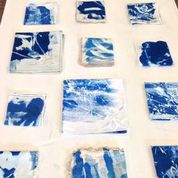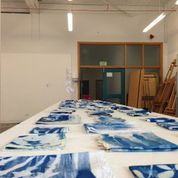 At our July seminar series I presented my cyanotype work for critique, with the thought in mind that I would develop this further for the January seminar. Below is the list of comments/words that were given about this work, as I asked my fellow students and staff for a cold reading of it;
At our July seminar series I presented my cyanotype work for critique, with the thought in mind that I would develop this further for the January seminar. Below is the list of comments/words that were given about this work, as I asked my fellow students and staff for a cold reading of it;
- association with English china blue - Wedgwood, Willow pattern, also Delft blue, something collectable
- filigree
- delicate
- aesthetically pleasing
- love it
- enjoying the tactile aspect
- Luscious (= appealing strongly to the senses, pleasingly rich)
- Enigmatic (= difficult to interpret or understand, mysterious)
- reading history - taking something that has age value but it is made contemporary through treatment of this.
- handmade, applied process
- bit like a memory game trying to link images & matching significance of patterns
domestic reading;
- dollies, hankies, napkins
- isolation from the home, a beautiful home
- making still/display
- images tension of the plants - possible weeds
- womanly craft - overt brush marks, mark making
- Her-story - passage of time from another time/sense of feminine history
- tension to be a contemporary, permission to be more domestic goddess
- not functional objects - folds suggest labour, order; can use them but you can’t
- table linen
- folded napkin - a place to keep a special keepsake
- use of napkin is a literalism (= interpretation in literal sense)
It was also seen as:
- a botanical collection
- pressing of flowers - but not in the same way as science, an instinctual collection, maybe plants as food or medicine
- layout; specimen like, like naturalist for investigation later
- pleasure in the order
- feel like a line of a research pattern
- considering it is a pre-existing object - its function gives it a tension or a disruption in the field
- Interesting to observe the design already present on the object and that these are floral related - gives them a history
- a trace of a thing, a stain, a trace via a chemical reaction.
- shroud - leaving a sense of what was
what is with the way are laid out? a denial of wholeness. this interrupts the image itself holding that sense of photography should we engage with them? jumble sale - the desire to unfold and refold symbolic representation fact they were not ironed flat is engaging - they have an organic sense about them, since they are not completely flat and perfectly creased like the uncontrolled nature of weeds - shown in this display strategy  Positives observed were: visually stunning luscious shibori & willow pattern reference history/herstory layering challenges the work posed: trying to overly compress to much into one single strategy why does the plant appear more than once? Questions that were asked during the 2 critique sessions: why are they folded? what is the strategy here? My answer was: the fact that we cannot see all of the image that is on the napkin, indicates to the sense of lost knowledge. To search and open the napkin is how we find this knowledge again. how would they look open? what is the gesture here?
Positives observed were: visually stunning luscious shibori & willow pattern reference history/herstory layering challenges the work posed: trying to overly compress to much into one single strategy why does the plant appear more than once? Questions that were asked during the 2 critique sessions: why are they folded? what is the strategy here? My answer was: the fact that we cannot see all of the image that is on the napkin, indicates to the sense of lost knowledge. To search and open the napkin is how we find this knowledge again. how would they look open? what is the gesture here?
 There are 2 rich signifiers: 1. in the substrate (the object) 2. the brush marks - very gestural. Comments was made by observer - feel the ones that are completely blue to edge more enticing Elle then asked: is there a desire to re-order? from big to small? No - this would look obsessive. Elle explained that these are plants we can eat, but have lost or are losing this knowledge = sense of loss folding implies a potential use - memory of that process, potential use. with the folding some of them make that connection with the image, but no edges are apparent. Victoriana is perhaps too much of a lead in, perhaps less of the brush mark edged ones. Is the mark making a distraction? should they all be completely blue to edges? Distracting from what? Comment was made that there is lots going on:
There are 2 rich signifiers: 1. in the substrate (the object) 2. the brush marks - very gestural. Comments was made by observer - feel the ones that are completely blue to edge more enticing Elle then asked: is there a desire to re-order? from big to small? No - this would look obsessive. Elle explained that these are plants we can eat, but have lost or are losing this knowledge = sense of loss folding implies a potential use - memory of that process, potential use. with the folding some of them make that connection with the image, but no edges are apparent. Victoriana is perhaps too much of a lead in, perhaps less of the brush mark edged ones. Is the mark making a distraction? should they all be completely blue to edges? Distracting from what? Comment was made that there is lots going on:
- am I testing out levels of historical references?
- maybe use different material? how important is it that they are on napkins?
- How important is it that partial image is shown?
- is it about the collection/a fragment or a whole within an image?
This critique has left me to ponder on this work and how to develop it from here. It received many good comments and observations, but in all honesty it did not appear to convey what I was trying to say; Lost plant knowledge/losing knowledge. Over the last few weeks I have tried to rethink the work, but the brain must have been too overloaded with information to even get something sensible out of it. So at this stage it has hit a bit of a wall. Not be concerned about that I did some research into Willow pattern, Wedgwood & Delft blue, as all 3 are blue and white patterns on dinner ware. All 3 are old and because of that have a collecting nature about them. This collecting nature was reflected by my work, so that is a positive.
The history behind the development & design of each of these 3 different is worth reading (Of the 3 Willow pattern has the strongest narrative within the pattern), but for me the interesting part is that all 3 have a strong botanical influence. The botanical on many of these 3 different approaches is often very stylized and has a strong William Morris feel to them. (Morris must have been influenced in his wallpaper & textile designs by these designs, as he came along almost a century after the 3 ceramic patterns had been around.) What all 3 are also giving me is the sense of collecting, treasures to be cared for and their history must be nurtured, not forgotten. This brings me to the questions that I have been asking myself since my critiques: How do I represent losing knowledge/lost plant knowledge? This then leads to: How do we ensure that knowledge is not lost? How do we pass on knowledge? These questions I have not resolved and I will continue to ask this also while I continue to look at the work and maybe re-phrase it, so that is does answer other questions I have or can pose.
